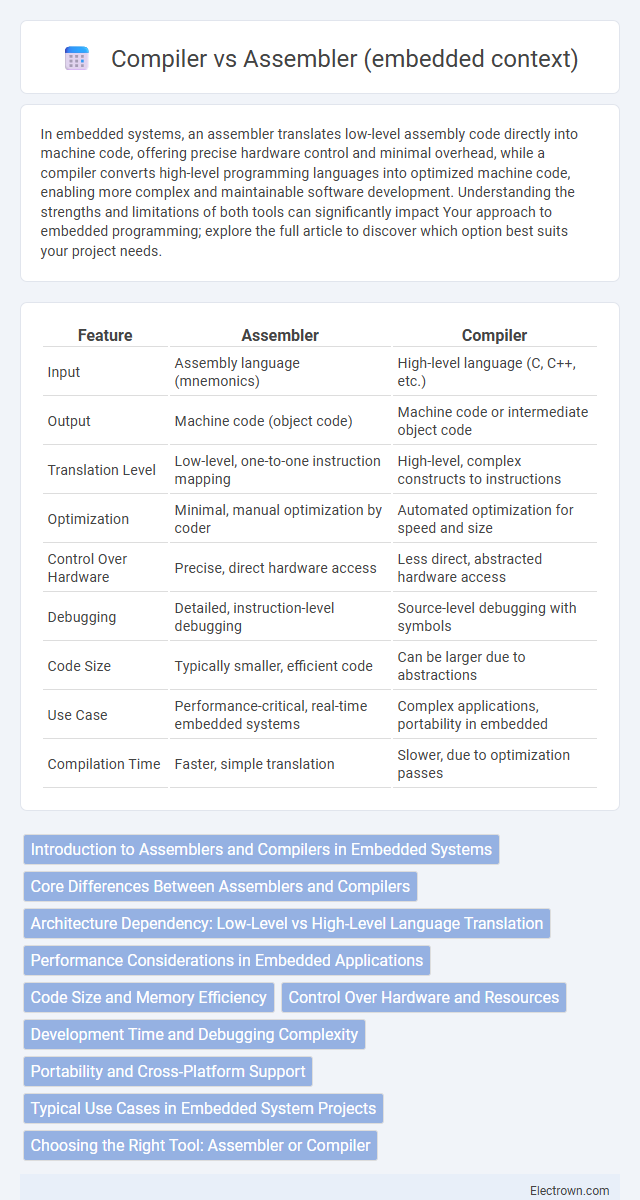In embedded systems, an assembler translates low-level assembly code directly into machine code, offering precise hardware control and minimal overhead, while a compiler converts high-level programming languages into optimized machine code, enabling more complex and maintainable software development. Understanding the strengths and limitations of both tools can significantly impact Your approach to embedded programming; explore the full article to discover which option best suits your project needs.
Table of Comparison
| Feature | Assembler | Compiler |
|---|---|---|
| Input | Assembly language (mnemonics) | High-level language (C, C++, etc.) |
| Output | Machine code (object code) | Machine code or intermediate object code |
| Translation Level | Low-level, one-to-one instruction mapping | High-level, complex constructs to instructions |
| Optimization | Minimal, manual optimization by coder | Automated optimization for speed and size |
| Control Over Hardware | Precise, direct hardware access | Less direct, abstracted hardware access |
| Debugging | Detailed, instruction-level debugging | Source-level debugging with symbols |
| Code Size | Typically smaller, efficient code | Can be larger due to abstractions |
| Use Case | Performance-critical, real-time embedded systems | Complex applications, portability in embedded |
| Compilation Time | Faster, simple translation | Slower, due to optimization passes |
Introduction to Assemblers and Compilers in Embedded Systems
Assemblers translate low-level assembly code directly into machine code specific to embedded processors, offering precise hardware control and efficient use of limited resources. Compilers, on the other hand, convert high-level programming languages like C into optimized machine code, enhancing development speed and maintainability in embedded applications. The choice between assembler and compiler impacts code size, execution speed, and system complexity in embedded system design.
Core Differences Between Assemblers and Compilers
Assemblers convert assembly language code directly into machine code specific to a microcontroller's architecture, translating mnemonic instructions one-to-one with hardware operations. Compilers transform high-level embedded programming languages like C or C++ into optimized machine code, performing complex analyses and code optimizations to improve performance and memory usage. The key difference lies in abstraction level and output; assemblers work with low-level, hardware-specific code, while compilers process high-level constructs into efficient binary suitable for embedded systems.
Architecture Dependency: Low-Level vs High-Level Language Translation
Assembler translates assembly language into machine code specific to a processor's architecture, enabling precise control over hardware with low-level instructions. Compiler converts high-level programming languages into machine code or intermediate code, often targeting multiple architectures through abstraction and optimization techniques. In embedded systems, assembler ensures architecture-dependent, efficient hardware manipulation, while compilers offer portability and easier code maintenance across various processors.
Performance Considerations in Embedded Applications
Assembler generates low-level machine code optimized for specific microcontrollers, resulting in faster execution and efficient memory use crucial for embedded systems with limited resources. Compilers offer higher-level code abstraction but may introduce overhead due to additional instructions for memory management or peripheral control. Your choice impacts the balance between development speed and runtime performance in performance-critical embedded applications.
Code Size and Memory Efficiency
Assembler generates low-level machine code directly tailored to the target embedded hardware, resulting in minimal code size and optimal memory efficiency. Compiler-produced code often includes additional instructions and abstractions, which can increase code size and consume more embedded system memory. Optimizing for embedded environments typically favors assembler for tight memory constraints despite higher development effort.
Control Over Hardware and Resources
Assembler offers direct control over hardware and resources by translating mnemonic codes into machine instructions specific to embedded systems, enabling precise manipulation of memory addresses and processor registers. Compiler abstracts this process by converting high-level code into machine code, which can optimize resource management but may limit fine-grained control over hardware. In embedded development, choosing between assembler and compiler depends on your need for detailed hardware interaction versus ease of programming and resource allocation efficiency.
Development Time and Debugging Complexity
Assembler offers faster development time in embedded systems by converting mnemonic code directly into machine language, enabling fine-grained hardware control and minimal abstraction layers. Compiler-generated code requires longer development cycles due to high-level language translation and optimization processes but simplifies debugging with advanced tools and error-checking features. Your choice influences project timelines and debugging complexity, balancing low-level control against streamlined problem-solving support.
Portability and Cross-Platform Support
Assemblers generate low-level machine code tailored to specific processor architectures, resulting in limited portability and minimal cross-platform support in embedded systems. Compilers translate high-level languages into intermediate or target-specific code, enhancing portability by enabling the same source code to be adapted across diverse embedded platforms. Cross-platform support in embedded development is primarily achieved through compiler frameworks that abstract hardware specifics, unlike assemblers which require rewriting code for each architecture.
Typical Use Cases in Embedded System Projects
Assemblers are typically used in embedded system projects that require direct hardware manipulation, low-level control, and highly optimized code for resource-constrained environments such as microcontrollers and real-time systems. Compilers convert high-level languages like C or C++ into machine code, enabling faster development cycles and easier maintenance for more complex embedded applications. Your choice depends on whether fine-grained hardware access or rapid software iteration is the priority in your embedded system project.
Choosing the Right Tool: Assembler or Compiler
Choosing between an assembler and a compiler for embedded systems depends on the specific requirements of your project, such as execution speed, memory constraints, and hardware control precision. Assemblers provide low-level control and generate highly optimized machine code ideal for time-critical or resource-limited applications, while compilers translate high-level code into efficient, readable, and maintainable software suited for complex algorithms and faster development. Your decision should balance the need for fine-grained hardware manipulation with development efficiency and portability in embedded environments.
Assembler vs Compiler (embedded context) Infographic

 electrown.com
electrown.com